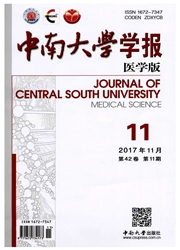

 中文摘要:
中文摘要:
目的:了解儿童与成人过敏性紫癜(Henoch-Sch?nlein purpura,HSP)在发病季节、发病诱因、临床表现、实验室检查和预后等方面的异同。方法:回顾性分析长治医学院附属和平医院皮肤性病科2013年2月至2016年1月337例诊断为HSP的住院患者的临床资料,根据年龄分为儿童组(〈14岁)和成人组(≥14岁),分析比较两组的发病率、发病诱因及治愈率。结果:儿童患者195例,成人患者142例,143例年龄≤10岁;儿童秋冬季发病率高于成人(P=0.006);儿童因上呼吸道感染诱发者多于成人(P〈0.01);年龄≥14岁(P=0.023)、皮肤紫癜复发≥3次(P=0.027)、有消化道症状(P=0.021)、抗链球菌溶血素O(anti-streptolysin O,ASO)增高(P=0.001)在肾易感因素logistic回归分析中有统计学意义;白细胞增高(P=0.001)、中性粒细胞百分比增高(P=0.001)、血小板增高(P=0.027)在消化道易感因素logistic回归分析中有统计学意义;儿童治愈率高于成人(P=0.002),无肾损害者治愈率高于有肾损害者(P〈0.01)。结论:HSP好发于儿童,尤其是≤10岁的儿童。和成人患者相比,儿童HSP易由上呼吸道感染诱发,肾损害相对较轻,预后更好。
 英文摘要:
英文摘要:
Objective: To determine differences in incidence, causes, clinical manifestation,prognosis between children and adults in patients with Henoch-Schonlein purpura (HSP). Methods: We retrospectively analyzed clinical data of 337 patients who hospitalized in the Department of Dermatology, Peace Hospital affiliated to Changzhi Medical College from Feb. 2013 to Jan. 2016. All patients were divided into two groups by age: a child group (patients were less than 14 years old) and an adult group (patients were more than or equal to 14 years old). The incidence, inducement, and recovery rates were compared between 2 groups.Results: There were 195 (57.86%) children and 142 (42.14%) adults in all subjects, and 143 (42.43%) were less than 10 years old. The incidence of HSP in children in autumn and winter was higher than that in adults (P〈0.05). Children with upper respiratory infection outnumbered adults (P〈0.01). Logistic analysis results showed that age more than 14 years old, gastrointestinal symptoms, skin purpura relapsed more than 3 times, and overexpression of anti-streptolysin O(ASO) were high risk factors for the HSP kidney damage (P〈0.05). Increased white blood cell count, high percentage ofneutrophil, and increased platelet count were independent risk factors for gastrointestinal symptoms (P〈0.05). The curative rates for children were higher than those of adults (P〈0.05) and curative rates of patients without kidney damage were higher than those in patients with kidney damage (P〈0.05). Conclusion: HSP mainly occurs in children, especially in those under 10 years old. Compared with adult patients, children with HSP are easy to be induced by upper respiratory tract infection, with relatively mild renal damage and better prognosis.
 同期刊论文项目
同期刊论文项目
 同项目期刊论文
同项目期刊论文
 期刊信息
期刊信息
